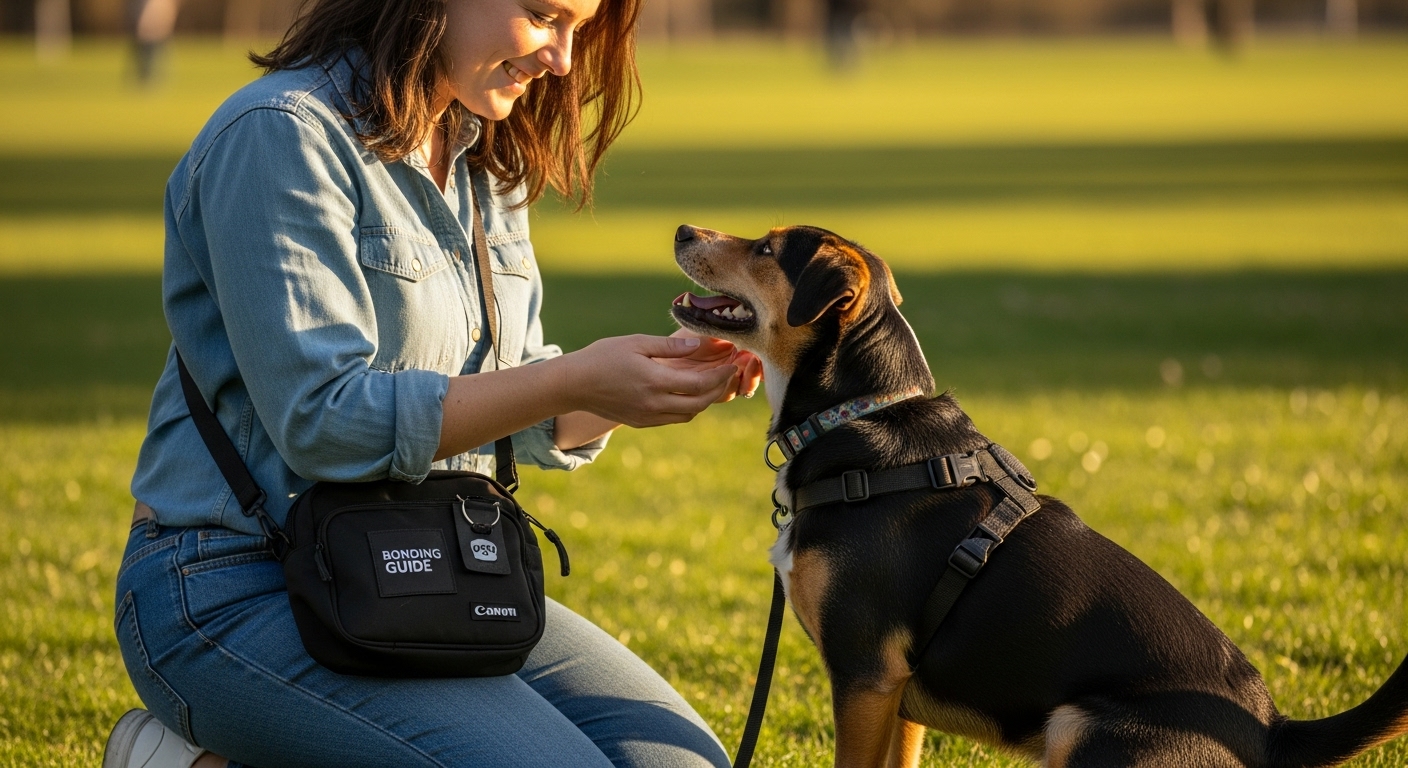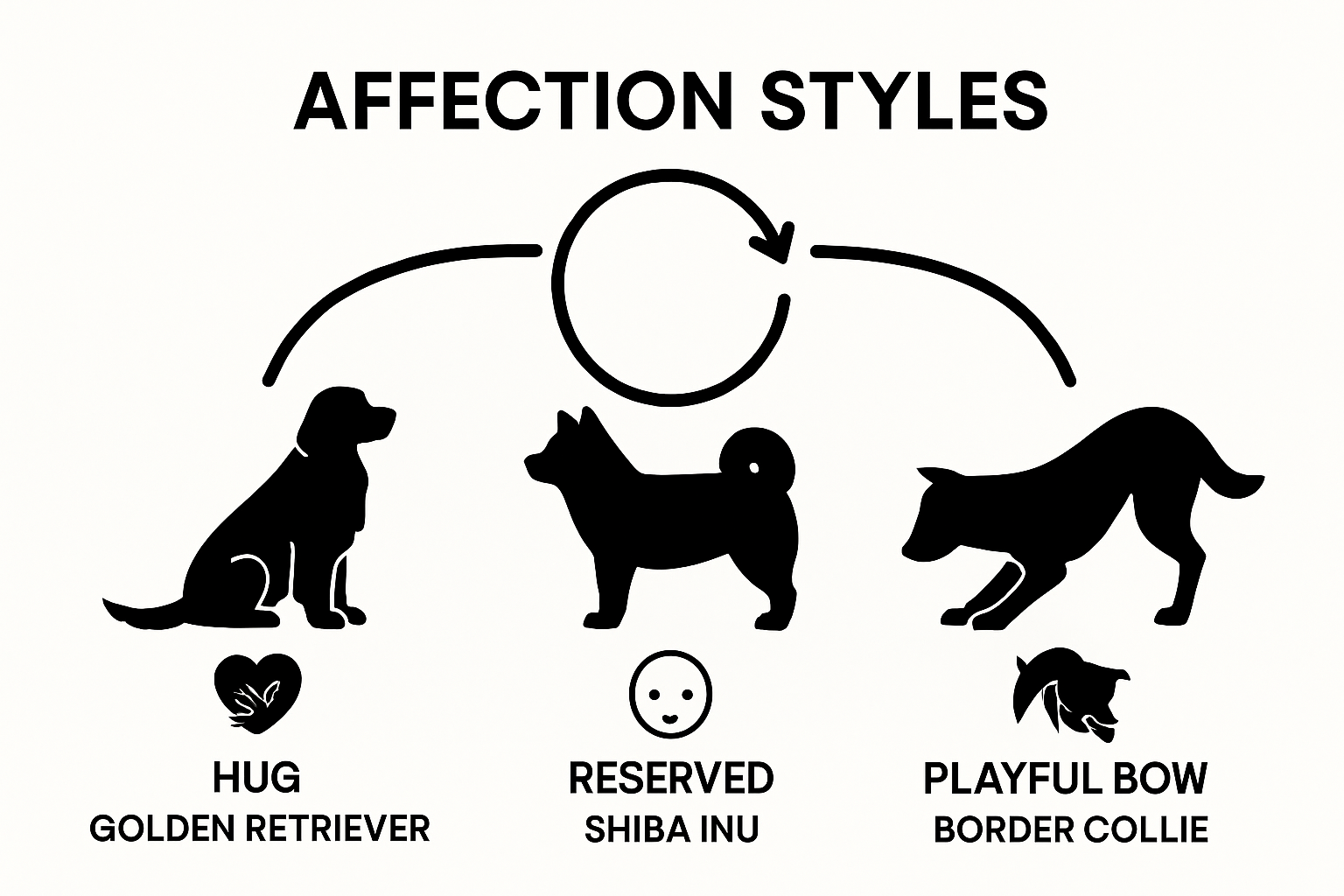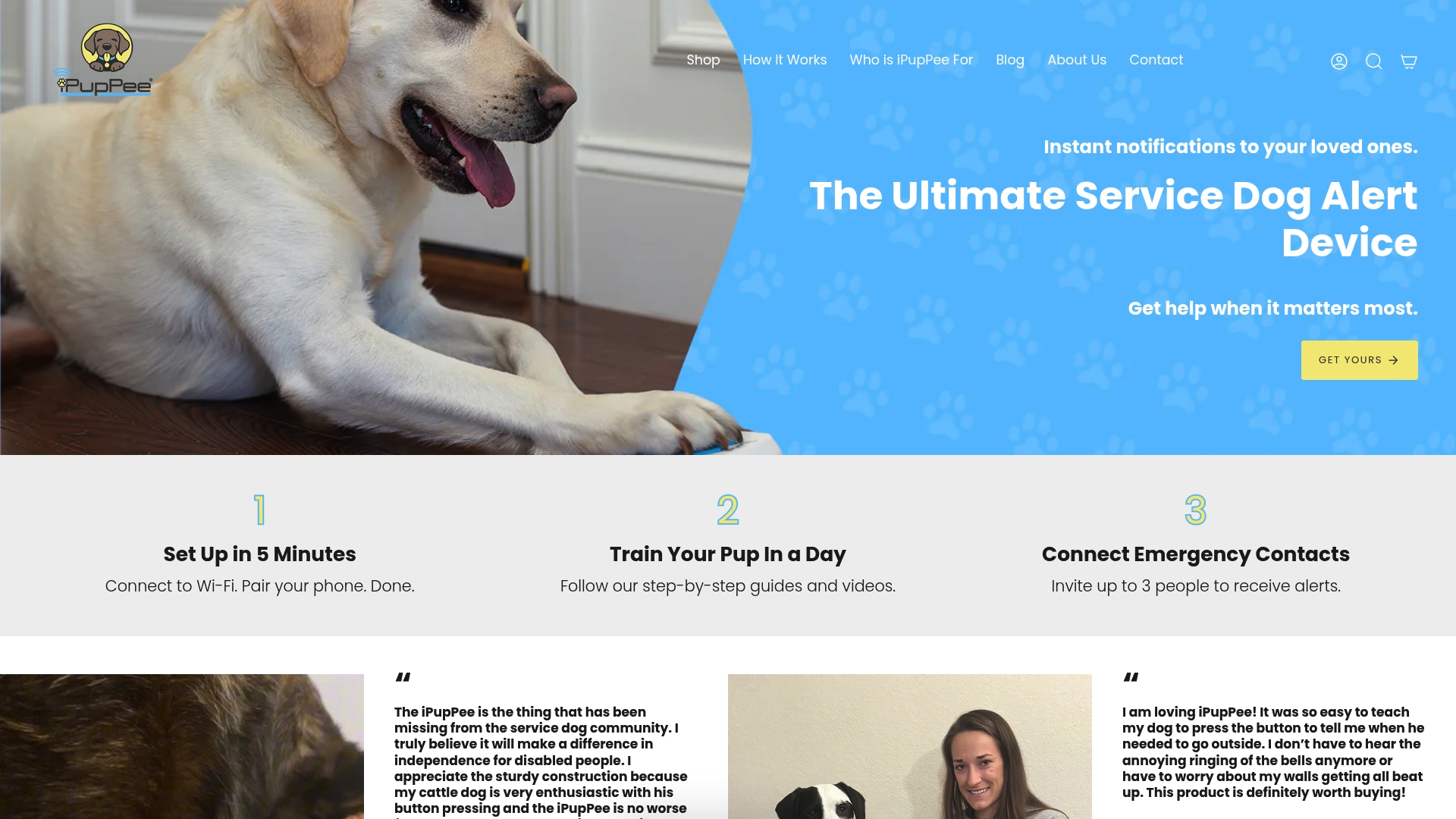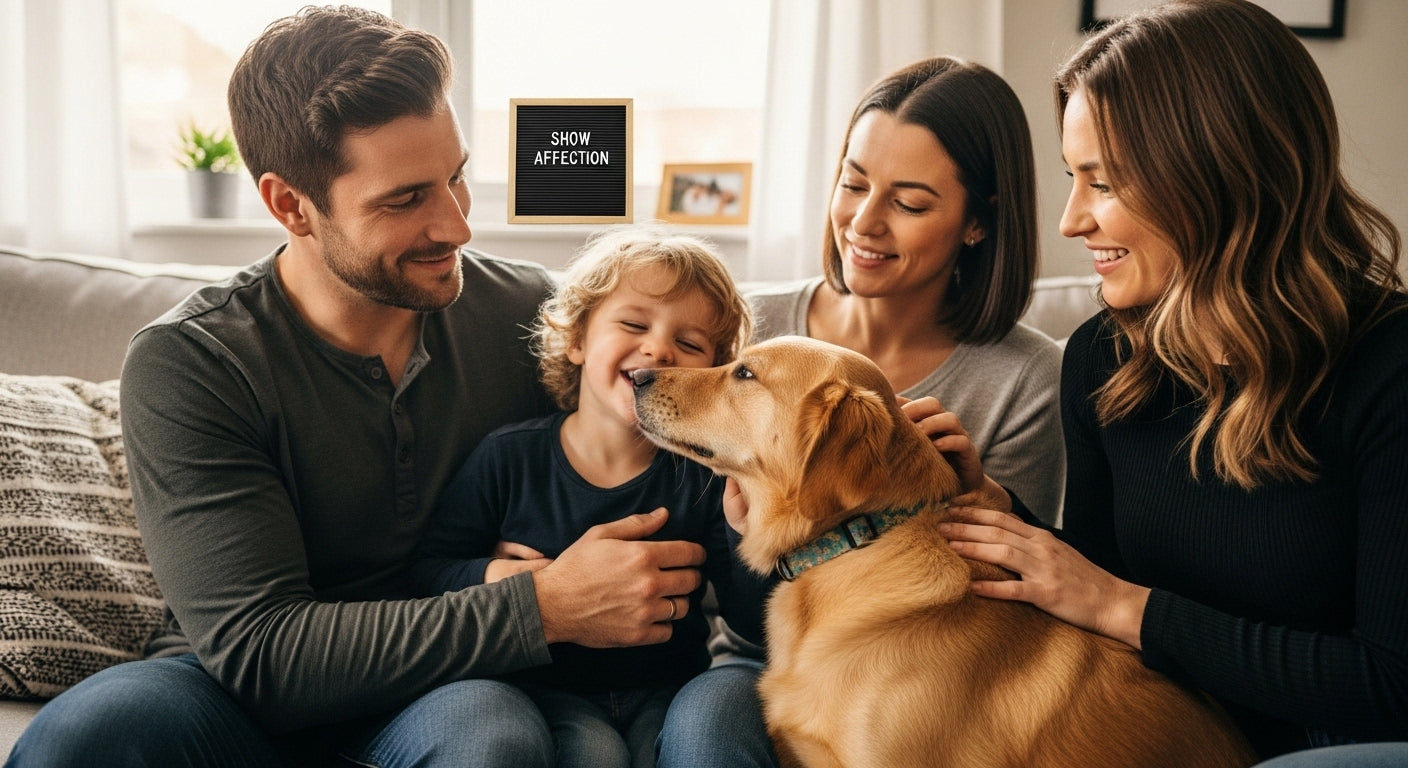Dog affection looks simple. A wagging tail here or a happy nuzzle there. But get this. When dogs interact with humans, their oxytocin levels can increase by up to 300 percent—the same hormone surge that bonds parents with newborns. Most people think it all boils down to petting or treats, yet the ways dogs form attachments are far richer and more complex than anyone expects.
Table of Contents
- What Does Affection Mean In Dogs?
- The Science Behind Canine Affection
- Common Ways Dogs Express Love
- The Importance Of Bonding With Your Dog
- Understanding Individual Differences In Affection
Quick Summary
| Takeaway | Explanation |
|---|---|
| Dogs express affection through behavior and interactions. | Canine affection is shown via physical closeness, nuzzling, and attentive monitoring of human emotions. |
| Oxytocin plays a key role in bonding. | Positive interactions with dogs trigger the release of oxytocin, reinforcing emotional connections between dogs and their owners. |
| Understanding individual dog behavior is crucial. | Each dog has unique ways of showing love influenced by genetics, early experiences, and temperament. |
| Human-dog bonding offers psychological benefits. | Strong ties with dogs can decrease loneliness, foster emotional resilience, and enhance overall mental health. |
| Dogs have evolved remarkable emotional intelligence. | Dogs possess advanced abilities to read human emotions and respond appropriately, enhancing interspecies communication and bonding. |
What Does Affection Mean in Dogs?
Affection in dogs represents a complex emotional and behavioral expression of attachment, trust, and social bonding deeply rooted in their evolutionary history as pack animals. When dogs demonstrate affection, they are communicating fundamental relationship dynamics that go far beyond simple physical gestures. These emotional displays reveal intricate neurological and social mechanisms developed through thousands of years of domestication and close interaction with humans.
The Biological Basis of Canine Affection
Dogs experience affection through a sophisticated interplay of hormonal and neurological processes. Scientific research from the National Institutes of Health demonstrates that oxytocin levels surge when dogs interact positively with their human companions, similar to the bonding mechanisms observed in parent infant relationships. This neurochemical response explains why dogs develop such profound emotional connections with their owners.
The biological underpinnings of canine affection involve multiple interconnected systems:
- Hormonal responses triggered by positive social interactions
- Neural pathways developed through consistent emotional experiences
- Evolutionary adaptations from their wolf ancestors
Social and Emotional Intelligence in Dogs
Understanding how dogs show affection requires recognizing their remarkable social intelligence. Dogs have developed nuanced communication strategies that allow them to express emotional states through body language, vocalization, and physical proximity. They read human emotional cues with extraordinary precision, often responding to subtle changes in tone, facial expressions, and body language.
These emotional communication skills are not merely instinctive but represent a sophisticated form of interspecies understanding. Dogs have evolved alongside humans for thousands of years, developing an unprecedented ability to form deep, meaningful connections that transcend traditional boundaries between species. Learn more about these fascinating connections in our guide on how dogs show emotions.
The Science Behind Canine Affection
The intricate neurological and physiological mechanisms that drive canine affection represent a remarkable intersection of evolutionary biology, neuroscience, and social adaptation. Dogs have developed sophisticated emotional intelligence that goes far beyond simple instinctual responses, creating a complex system of communication and bonding with humans that is rooted in deep neurochemical processes.
Neurochemical Foundations of Dog Emotional Bonding
Research from Scientific American reveals that dogs experience genuine emotional connections through measurable neurological responses. Brain imaging studies using functional MRI have demonstrated that dogs exhibit similar neural activation patterns to humans when experiencing positive social interactions. The caudate nucleus, a critical brain region associated with reward and emotional processing, becomes highly active during interactions with trusted human companions.
Key neurochemical processes involved in canine affection include:
- Oxytocin release during positive social interactions
- Dopamine reward system activation
- Neuroplastic changes reinforcing social bonding
Evolutionary Adaptations in Emotional Communication
The capacity for emotional bonding in dogs is not accidental but a result of thousands of years of co-evolution with humans. Dogs have developed an extraordinary ability to read and respond to human emotional cues, a skill that far surpasses other domesticated animals. This emotional intelligence allows them to interpret subtle changes in human facial expressions, tone of voice, and body language with remarkable precision.
These adaptive capabilities demonstrate that dogs do not merely respond to commands but engage in nuanced emotional communication. Their ability to form deep, meaningful connections reflects a sophisticated interspecies emotional intelligence that continues to fascinate researchers. Learn more about the incredible emotional world of dogs in our comprehensive guide on dog emotional connections.
Common Ways Dogs Express Love
Dogs communicate affection through a rich and nuanced repertoire of behaviors that go well beyond simple tail wagging.
Their expressions of love are sophisticated, multifaceted communication strategies that demonstrate deep emotional intelligence and a profound connection with their human companions.
Physical Affection and Proximity Signals
Research from The Conversation highlights that dogs use multiple physical gestures to demonstrate their emotional attachment. These behaviors are intentional signals designed to strengthen social bonds and communicate trust, comfort, and deep affection.
Key physical expressions of canine love include:
- Leaning against their owner’s body
- Seeking physical contact and close proximity
- Gentle nuzzling and soft physical touches
- Offering their belly for rubs as a sign of vulnerability
Behavioral Indicators of Emotional Connection
Beyond physical touch, dogs express love through complex behavioral patterns that reveal their emotional depth. These actions demonstrate their ability to read human emotions and respond with remarkable empathy. Dogs might follow their owners from room to room, constantly monitor their emotional state, and adjust their behavior to provide comfort during stressful moments.
Interestingly, dogs also show love through seemingly playful actions like bringing toys, making direct eye contact, and performing what animal behaviorists call a “play bow” — a universal canine gesture of friendly intentions.
To help readers quickly compare the different ways dogs show affection, the table below summarizes common physical and behavioral indicators of canine love alongside their significance to the human-dog bond.
| Expression Type | Example Behavior | Significance in Dog-Human Bond |
|---|---|---|
| Physical Affection | Leaning against the owner | Shows trust, seeks comfort and closeness |
| Physical Affection | Seeking physical contact/proximity | Demonstrates attachment and security |
| Physical Affection | Gentle nuzzling or soft touches | Reinforces social and emotional connection |
| Physical Affection | Offering belly for rubs | Expresses vulnerability and deep trust |
| Behavioral Indicator | Following owner from room to room | Indicates loyalty and strong attachment |
| Behavioral Indicator | Bringing toys to the owner | Shares resources, initiates play as bonding |
| Behavioral Indicator | Making direct eye contact | Enhances emotional connection, mutual trust |
| Behavioral Indicator | Performing a play bow | Signals friendly intentions, builds rapport |
| These behaviors are not random but calculated expressions of their emotional commitment. Learn more about building deeper connections with your dog in our comprehensive bonding guide. |
The Importance of Bonding with Your Dog
The human-dog relationship transcends simple companionship, representing a profound emotional connection that impacts psychological, physiological, and social well-being for both species. Understanding the multifaceted significance of bonding helps dog owners cultivate deeper, more meaningful relationships with their canine companions.
Psychological and Emotional Benefits
Research published in the National Institutes of Health demonstrates that strong emotional bonds between humans and dogs produce remarkable psychological benefits. These connections reduce stress, lower blood pressure, and create mutual emotional support systems that enhance mental health for both humans and dogs.
Key psychological advantages of strong dog-human bonds include:
- Decreased feelings of loneliness and isolation
- Enhanced emotional resilience
- Improved mood regulation
- Increased sense of companionship and social connection
Long-Term Health and Development Impacts
Bonding is not merely an emotional luxury but a critical component of canine psychological development. Dogs who experience consistent, positive human interactions develop better emotional intelligence, improved behavioral adaptability, and more robust social skills. These interactions shape their neurological responses, creating lasting psychological frameworks that influence their ability to form healthy relationships throughout their lives.
The quality of early bonding experiences significantly determines a dog’s future social capabilities, emotional stability, and capacity for trust. Consistent, positive interactions build neurological pathways that support emotional regulation and social understanding.
The following table provides a quick overview of key psychological and long-term developmental benefits that result from strong human-dog bonding, making it easier to see how these affect both you and your pet.
| Benefit Type | Human Benefit | Dog Benefit |
|---|---|---|
| Psychological/Emotional | Reduced loneliness and isolation | Increased sense of security and emotional support |
| Psychological/Emotional | Enhanced emotional resilience | Improved mood regulation |
| Psychological/Emotional | Improved mood regulation | Enhanced ability to handle stress |
| Long-Term Developmental | Greater overall mental well-being | Better behavioral adaptability |
| Long-Term Developmental | Increased companionship and social connection | Stronger social skills and emotional intelligence |
| Long-Term Developmental | Lower blood pressure and stress levels | More robust neurological development |
| Learn more about building strong connections with your furry companion in our comprehensive dog training and bonding guide. |

Understanding Individual Differences in Affection
Just as humans have unique personality traits, dogs exhibit remarkable individual variations in how they express and experience affection. These differences are shaped by a complex interplay of genetic predisposition, early socialization experiences, breed characteristics, and individual temperament.
Breed-Specific Affection Patterns
Research from Animal Behavior Studies reveals that different dog breeds demonstrate distinctly unique affection styles. Some breeds are naturally more demonstrative, while others express love through more subtle, reserved behaviors. These variations are deeply rooted in their evolutionary history, breeding purposes, and genetic lineage.
Factors influencing breed-specific affection patterns include:

- Historical breeding purposes
- Genetic predispositions
- Inherited social interaction traits
- Neurological temperament variations
Psychological and Environmental Influences
Beyond breed characteristics, individual dogs develop unique affection styles based on their personal experiences. Early socialization, traumatic experiences, individual personality, and the quality of human interactions profoundly shape how a dog expresses emotional attachment. Some dogs might be naturally more reserved, while others are exuberantly demonstrative.
These individual differences highlight the importance of understanding and respecting each dog’s unique emotional language. Recognizing that affection is not a one-size-fits-all experience allows owners to build more nuanced, empathetic relationships with their canine companions. Learn more about understanding your dog’s unique emotional communication in our guide to dog emotional intelligence.
Turn Understanding into Real Communication with iPupPee
You have just learned how deeply dogs express affection and how important emotional connection is for trust and safety. But even with the best understanding, many owners still wish their dogs could clearly communicate urgent needs or share loving signals when words fail. This gap can be especially stressful for people living alone, those with service animals, or anyone worried about missing critical cues from their companion.

Imagine taking your bond to the next level. The iPupPee device empowers your dog to press a button and instantly alert you when they need attention, want to go outside, or simply wish to connect. This practical solution supports everything you value—clearer communication, greater independence, and peace of mind. Join pet owners who already use iPupPee to foster safer and more meaningful connections. Discover how this device can change your daily life by visiting our home page, and check out our helpful training instructions to see how easily you and your dog can get started. Move from understanding your dog’s affection to truly sharing important moments—act now to transform your relationship.
Frequently Asked Questions
How do dogs show affection to their owners?
Dogs express affection through various behaviors, such as leaning against their owners, seeking physical contact, offering their belly for rubs, and following their owners from room to room.
What is the biological basis of canine affection?
Canine affection is rooted in hormonal and neurological processes involving hormones like oxytocin, which increases during positive interactions between dogs and humans. This reflects the emotional bond developed through long-term socialization.
How does breed affect a dog’s way of showing affection?
Different dog breeds exhibit unique affection styles influenced by their historical breeding purposes and genetic predispositions. Some breeds are more demonstrative, while others may express love in more subtle ways.
Why is bonding with my dog important?
Bonding with your dog has numerous psychological and emotional benefits, including reduced stress levels, improved mood, and increased companionship. Strong emotional connections also enhance a dog’s social skills and emotional intelligence.

